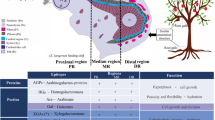Abstract
Fungal mycelium of the fly agaric (Amanita muscaria [L. ex Fr.] Hooker), and inoculated or noninoculated seedlings of Norway spruce (Picea abies [L.] Karst.) were grown aseptically under controlled conditions. In order to detect symbiosis-specific polypeptides (‘ectomycorrhizins’, see Hubert and Martin, 1988, New Phytol.110, 339–346) the protein patterns of (i) fungal mycelium, (ii) mycorrhizal, and (iii) non-mycorrhizal root tips were compared by means of one- and twodimensional electrophoresis on a microscale. Because of the sensitivity of these micromethods (50 and 200 ng of protein, respectively), single mycorrhizal root tips and even the minute quantities of extramatrical mycelium growing between the roots of inoculated plants could be analysed. Differences in the protein patterns of root tips could be shown within the root system of an individual plant (mycorrhizal as well as non-mycorrhizal). In addition, the protein pattern of fungal mycelium grown on a complex medium (malt extract and casein hydrolysate) differed from that of extramatrical mycelium collected from the mycorrhiza culture (pure mineral medium). Such differences in protein patterns are obviously due to the composition of the media and/or different developmental stages. Consequently, conventional analyses which use extracts of a large number of root tips, are not suitable for differentiating between these effects and symbiosis-specific differences in protein patterns. In order to detect ectomycorrhizins, it is suggested that roots and mycelium from individual, inoculated plants should be analysed. This approach eliminates the influence of differing media, and at the same time allows a correct discrimination between developmental and symbiosisspecific changes. In our gels we could only detect changes in spot intensity but could not detect any ectomycorrhizins or the phenomenon of polypeptide ‘cleansing’, which both characterize theEucalyptus-Pisolithus symbiosis (Martin and Hubert, 1991, Experientia47, 321–331). We thus suggest that these reported effects either are specific for theEucalyptus-Pisolithus symbiosis or simply represent artifacts. The latter point of view is strengthened by a comparison of the experimental approaches.
Similar content being viewed by others
Abbreviations
- IEF:
-
isoelectric focusing
- MMN:
-
modified-Melin-Norkrans
- SDS:
-
sodium dodecyl sulfate
References
Ames, G.F.L., Nikaido, K. (1976) Two-dimensional gel electrophoresis of membrane proteins. Biochemistry15, 616–623
Colas des Francs, C., Thiellement, H., De Vienne, D. (1985) Analysis of leaf proteins by two-dimensional gel electrophoresis. Plant Physiol.78, 178–182
Denny, H.J., Wilkins, D.A. (1987) Zinc tolerance inBetula spp. IV. The mechanism of ectomycorrhizal amelioration of zinc toxicity. New Phytol.106, 545–553
Gianazza, E., Astrua-Testori, S., Righetti, P.G. (1985) Some more formulations for immobilized pH gradients. Electrophoresis6, 113–117
Guttenberger, M. (1989) Untersuchungen zur Biochemie der Pilz-Baumwurzel-Symbiose: Proteinanalytik im Mikromaßstab. Ph.D. thesis, Faculty of Biology, University of Tübingen, FRG
Guttenberger, M., Neuhoff, V., Hampp, R. (1991) A dot-blot assay for quantitation of nanogram amounts of protein in the presence of carrier ampholytes and other possibly interfering substances. Anal Biochem.196, 99–103
Hilbert, J.L., Martin, F. (1988) Regulation of gene expression in ectomycorrhizas I. Protein changes and the presence of ectomycorrhiza-spezific polypeptides in thePisolithus-Eucalyptus symbiosis. New Phytol.110, 339–346
Hubert, J.L., Costa, G., Martin, F. (1991) Ectomycorrhizin synthesis and polypeptide changes during the early stage of eucalypt mycorrhiza development. Plant Physiol.97, 977–984
Kottke, I., Guttenberger, M., Hampp, R., Oberwinkler, F. (1987) An in vitro method for establishing mycorrhizae on coniferous tree seedlings. Trees1, 191–194
Laemmli, U.K. (1970) Cleavage of structural proteins during the assembly of the head of bacteriophage T4. Nature227, 680–685
Legocki, R.P., Verma, D.P.S. (1979) A nodule-specific plant protein (nodulin-35) from soybean. Science205, 190–193
Loomis, W.D., Battaile, J. (1966) Plant phenolic compounds and the isolation of plant enzymes. Phytochemistry5, 423–438
Lowry, O.H., Rosebrough, N.J., Farr, A.L., Randall, R.J. (1951) Protein measurement with the Folin phenol reagent. J. Biol. Chem.193, 265–275
Martin, F.M., Hilbert, J.L. (1991) Morphological, biochemical and molecular changes during ectomycorrhiza development. Experientia47, 321–331
Neuhoff, V. (1973) Micro-homogenisation. In: Micromethods in molecular biology, pp. 399–402, Neuhoff, V., ed. Springer, Berlin Heidelberg New York
Neuhoff, V., Stamm, R., Eibl, H. (1985) Clear background and highly sensitive protein staining with Coomassie Blue dyes in polyacrylamide gels: A systematic analysis. Electrophoresis6, 427–448
O'Farrell, P.H. (1975) High resolution two-dimensional electrophoresis of proteins. J. Biol. Chem.250, 4007–4021
Poehling, H.M., Neuhoff, V. (1980) One and two-dimensional electrophoresis in micro-slab gels. Electrophoresis1, 90–102
Poehling, H.M., Neuhoff, V. (1981) Visualisation of proteins with a silver “stain”: A critical analysis. Electrophoresis2, 141–147
Ramstedt, M., Söderhäll, K. (1983) Protease, phenoloxidase and pectinase activities in mycorrhizal fungi. Trans. Br. Mycol. Soc.81, 157–161
Wyss, P., Mellor, R.B., Wiemken, A. (1990) Vesicular-arbuscular mycorrhizas of wild-type soybean and non-nodulating mutants withGlomus mosseae contain symbiosis-specific polypeptides (mycorrhizins), immunologically cross-reactive with nodulins. Planta182, 22–26
Author information
Authors and Affiliations
Additional information
This work was supported by the Deutsche Forschungsgemeinschaft. The authors are indebted to N. Arold and V. Neuhoff (Max-Planck-Institut für experimentelle Medizin, Göttingen, FRG) for their expert advice in adopting the techniques of micro-electrophoresis and to C. Schaeffer and H. Thelen (Botanisches Institut, Universität Tübingen, Tübingen, FRG) for critical reading of the manuscript.
Rights and permissions
About this article
Cite this article
Guttenberger, M., Hampp, R. Ectomycorrhizins — symbiosis-specific or artifactual polypeptides from ectomycorrhizas?. Planta 188, 129–136 (1992). https://doi.org/10.1007/BF01160722
Received:
Accepted:
Issue Date:
DOI: https://doi.org/10.1007/BF01160722




